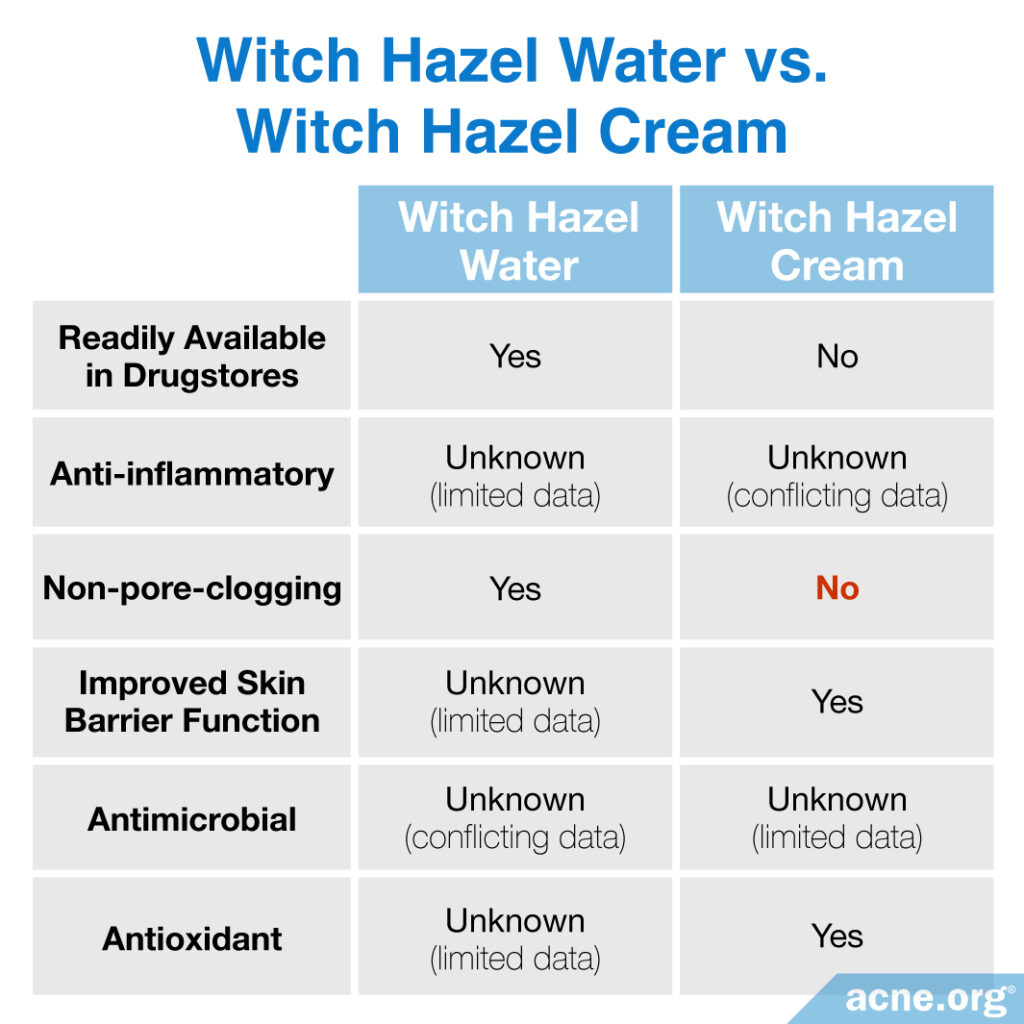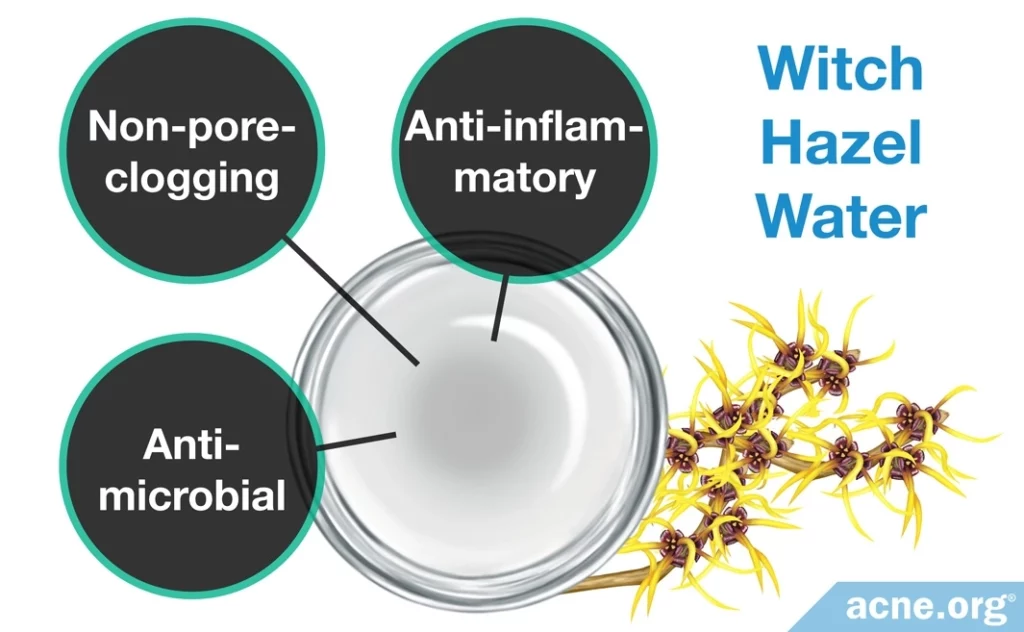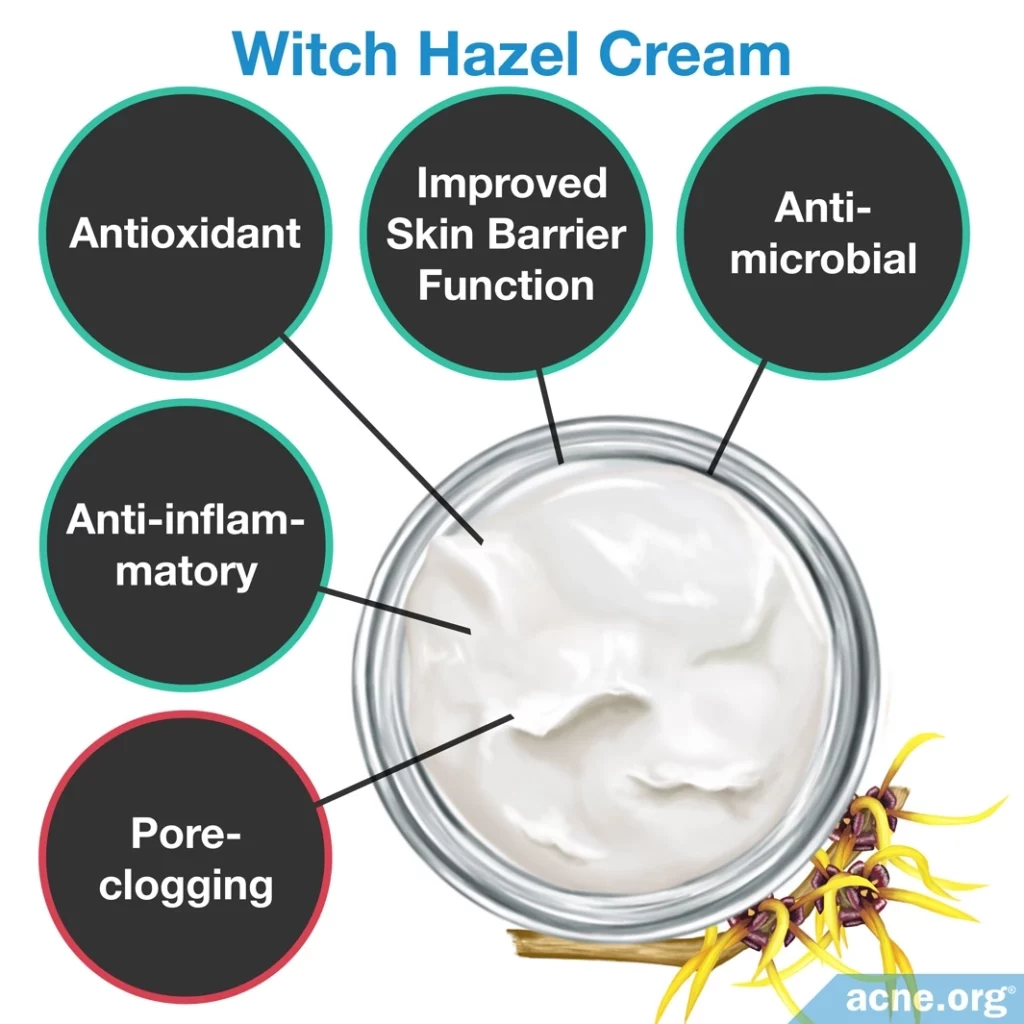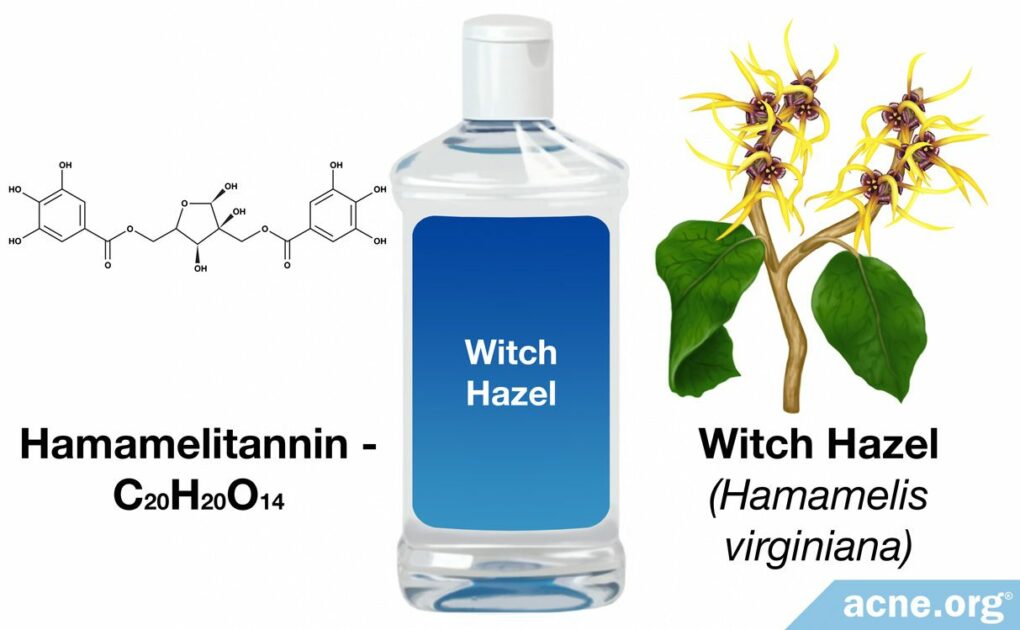Witch Hazel Is Mildly Antibacterial and Anti-inflammatory, But We Don’t Have Enough Evidence to Know if It Will Help with Acne

The Essential Info
Witch hazel is an astringent, which basically means it tightens and dries out the skin. Using witch hazel, particularly on oily skin, imparts a “fresh” and “clean” feeling. However, the activity of witch hazel is relatively weak, and evidence doesn’t point toward a major benefit for acne-prone skin.
Witch hazel can come in two forms:
- Witch hazel water, the type available at drugstores
- Witch hazel cream, which is in some medications
Researchers have never studied either form of witch hazel for treating acne, so we don’t know if they would help. Even if they did, it’s unlikely they would provide dramatic clearing of acne.
Witch hazel water shows the most promise for acne treatment because it may be:
- Mildly anti-inflammatory – acne is an inflammatory disease, so this could potentially help with acne
- Antimicrobial – data on this is weaker, but since acne is in part a bacterial disease, if witch hazel really is antimicrobial, this could also help
- Non-comedogenic (won’t clog pores) – this means it should be safe to try
Witch hazel cream might provide the same benefits of witch hazel water, and additionally may possess antioxidant properties, which could theoretically help with acne as well. On the other hand, some evidence points toward the possibility that witch hazel cream might be comedogenic (clogs pores), so it’s probably best not to use it.
The Bottom Line: Witch hazel is unlikely to dramatically clear the skin, but if you want to try witch hazel on acne, try witch hazel water, which is normally packaged in large bottles of clear watery liquid and is available at most drugstores. Make sure to stay realistic and don’t expect it to provide substantial improvement in acne.

The Science
Witch Hazel and Its Potential for Healing
Witch hazel (Hamamelis virginiana) is a shrub native to eastern North America. For centuries, Native Americans treated a variety of medical conditions with pastes and water that contained extracts of the bark and leaves of the witch hazel plant.
The pharmaceutical industry first commercialized witch hazel water in the late 1800s, and modern manufacturers of skin care products still use witch hazel in a variety of products designed to treat skin conditions like varicose veins, hemorrhoids, eczema, and psoriasis.1,2
Witch Hazel Water vs. Witch Hazel Cream

Witch hazel comes in two forms, (1) witch hazel water, and (2) witch hazel cream, and they differ in their chemical compositions and potential for acne treatment.
Witch hazel water is what you might commonly purchase at the drugstore and is the type of witch hazel you should opt for if you want to try witch hazel for acne. Manufacturers create witch hazel water by distilling witch hazel leaves and bark into a solution of 13 – 15% alcohol. The distillation process does not preserve compounds in witch hazel called tannins, which have antioxidant properties. However, it does still contain high levels of molecules called polysaccharides. Polysaccharides can be anti-inflammatory and antimicrobial, both of which may be beneficial to acne. Witch hazel water also most likely does not clog pores.
Witch hazel cream does not go through the process of distillation, and so it still contains the tannins from the leaves and bark of the witch hazel plant. Like witch hazel water, it may be anti-inflammatory and antimicrobial. The tannins in witch hazel cream may also have antioxidant properties that can theoretically help with acne, and may help improve the skin’s barrier function, which could also be beneficial for acne.1,3 All of this might make it seem like witch hazel cream would be superior, but the tannins in hazel cream might lead to clogged pores. Therefore, witch hazel cream should be avoided for people with acne-prone skin.
To date, there is no data from clinical trials that examine the role of any form of witch hazel in treating acne. However, witch hazel demonstrates properties that may affect acne in both positive and negative ways, depending on the form of witch hazel used.
Scientists generally study witch hazel in the two forms that we mentioned: witch hazel cream and witch hazel water. First, let’s look at the science regarding witch hazel water, which is the more common of the two.
Witch Hazel Water

Data from studies on witch hazel water shows that it may exhibit the following properties:
- Anti-inflammatory: There is a some evidence, mostly from studies on skin cells grown in the lab, suggesting that witch hazel water acts as an anti-inflammatory agent. This is relevant to acne since acne is at its core an inflammatory disease.
- Antimicrobial: Witch hazel water might be mildly antibiotic, and acne is made worse by bacteria, specifically a type of bacteria called C. acnes.
- Non-pore-clogging: Witch hazel water does not appear to promote pore clogging. This relates to acne since acne lesions begin from clogged pores.
Expand the drawer below to look at research on witch hazel water.
Expand to read details of studies
Anti-inflammatory: Acne is an inflammatory disease. Four studies have tested the anti-inflammatory properties of witch hazel water: 3 on human skin cells grown in the lab and 1 on animals. These studies reached the preliminary conclusion that witch hazel water might reduce inflammation. However, studies on human patients are necessary to confirm this finding.

The first study, published in the Journal of Inflammation in 2011, tested witch hazel water on human skin cells grown in the lab.
To determine whether witch hazel water helps with inflammation, the researchers first needed to create inflammation in the skin cells. They did this by exposing the cells to hydrogen peroxide, which injured the cells and stimulated them to produce inflammatory substances. The scientists then measured the amount of inflammatory substances as a sign of how much inflammation the skin cells were experiencing.
Next, the scientists took a new batch of skin cells and applied witch hazel water to the cells before exposing them to hydrogen peroxide. They then measured the amount of inflammatory substances in these cells. The scientists found that witch hazel water reduced inflammation in the skin cells by over 80%.4 However, since the study only looked at isolated cells in the lab, tests on patients are necessary to confirm that witch hazel water helps with inflammation in real people.

Similarly, a study published in the International Journal of Molecular Sciences in 2022 tested the anti-inflammatory properties of witch hazel water on human skin cells grown in the lab. First, the researchers induced inflammation in the skin cells by placing them in a solution of molecules called cytokines, which trigger inflammation in the human body. The skin cells responded by releasing inflammatory substances that are a normal part of an allergic or immune response. Then, the scientists tested whether treating the skin cells with witch hazel extract for 24 hours before adding the cytokine solution would prevent this kind of inflammatory reaction. They found that witch hazel extract reduced the human skin cells’ inflammatory response in a dose-dependent manner, which means that the more witch hazel extract they used, the stronger the anti-inflammatory effect.5

The same year, the journal Antioxidants published another study on human skin cells, this one looking specifically at how witch hazel might help with inflammation caused by acne bacteria. First, the researchers infected human skin cells grown in the lab with the acne bacteria C. acnes. The scientists then measured the amount of inflammatory substances the skin cells were producing in response, as an indication of the amount of inflammation that the acne bacteria had caused in the skin cells. Next, the researchers treated the skin cells with either witch hazel extract or its main active compound, hamamelitannin, for 48 hours. They then looked at the amount of acne bacteria still growing on the skin cells as well as the amount of inflammatory substances produced by the cells. They found that neither witch hazel extract nor hamamelitannin was able to stop the growth of C. acnes. However, both witch hazel extract and hamamelitannin reduced inflammation in the skin cells. Since the inflammation in the skin cells was directly caused by acne bacteria, this result gives us some hope that witch hazel might have some medicinal effect on acne.6 However, studies on real human patients are necessary to test this idea.

Finally, one study in rats, published in the Journal of Pharmacy and Pharmacology in 1994, examined two types of inflammation: (1) inflammation associated with injuries to the rats’ paws, and (2) inflammation associated with arthritis in the rats.
The data showed that the witch hazel water had no effect on swelling from the paw injuries, but it did reduce the inflammation associated with arthritis.2 The data from this study indicates that witch hazel water may help with some types of inflammation, but because of the preliminary nature of this study and because it was performed in animals, we do not know if it confers the same effect in humans.
Antimicrobial: The strain of bacteria called C. acnes aggravates acne, so the antibacterial activity of witch hazel may be helpful in acne treatment. A study published in 2002 in the German medical journal Naturheilkunde examined the efficacy of witch hazel water on bacteria:

Fifteen study participants applied witch hazel water to their skin, and the scientists tested their skin for microbes. Additionally, the scientists conducted an in vitro experiment in which they examined the effect of witch hazel water on various bacteria in the lab, under the microscope. The witch hazel water showed antibiotic and antifungal activity both in the skin of the participants and in the lab, but this activity was weak when compared to traditional antibiotics that they tested.3 In other words, witch hazel might help reduce bacteria to some degree.

However, as mentioned earlier, the lab study on human skin cells that was published in the journal Antioxidants in 2022 found that witch hazel extract failed to block the growth of acne bacteria.6 Therefore, it is uncertain whether witch hazel has any meaningful antibacterial activity when it comes to fighting acne.
Non-pore-clogging: An acne lesion arises from a clogged pore in the skin. Keratinocytes are skin cells that produce a protein called keratin, which can clog pores and cause acne lesions. A 2001 study examined the role of witch hazel water in regulating the overproduction of keratinocytes.

The in vitro study examined specifically the effect of the polysaccharides in witch hazel water. Data shows that they did not affect the production of keratinocytes and that witch hazel water is not likely to increase pore clogging.7
Witch Hazel Cream

Now let’s look at the science regarding witch hazel cream, which is less commonly available at drugstores.
Data from studies on witch hazel cream shows that it may exhibit the following properties:
- Anti-inflammatory: Some data suggest that witch hazel cream may act as an anti-inflammatory agent, but not all the data supports this claim.
- Antimicrobial: A very limited amount of data suggest that witch hazel cream might be mildly antimicrobial.
- Antioxidant: Witch hazel cream appears to have antioxidant properties, and this may help keep the skin healthy and potentially reduce acne.
- Skin Barrier Improvement: Witch hazel cream may strengthen the skin’s barrier. This is significant because people with acne tend to have an impaired skin barrier.
- Pore-clogging: Unlike witch hazel water, the tannins in witch hazel cream may promote pore clogging. This could potentially lead to more acne.
Expand the drawer below to look at research on witch hazel water.
Expand to read details of studies
Anti-inflammatory: Just like with witch hazel water, there are no studies to date that investigate the effect of witch hazel cream directly on acne, so we must rely on studies that examine witch hazel cream on other inflammatory skin conditions and then make educated guesses from there. These studies show that witch hazel cream may be anti-inflammatory, but it has not demonstrated this effect in all the studies. Therefore, more research is needed to confirm its anti-inflammatory properties.

A 2007 study examined the role of a witch hazel cream – including the tannins that make up witch hazel – in reducing dermatitis. Dermatitis is a term used to describe general skin inflammation. The study, published in the European Journal of Pediatrics, investigated the effect of witch hazel ointment in comparison to dexpanthenol ointment, which is a standard treatment for dermatitis. The study involved a group of 309 children who were chosen based on a variety of skin problems, including minor skin injuries, diaper dermatitis, and localized inflammation. After an average of 8 days of treatment, each ointment caused a significant decrease in symptoms. Both treatments also were well tolerated, although patients tolerated the witch hazel ointment slightly better.8

In another study published in 1993 in the European Journal of Clinical Pharmacology, researchers induced skin irritation in 24 healthy volunteers by creating fresh injuries to their skin. The researchers created the irritation by exposing the skin of 24 healthy volunteers to the sun’s rays and also by applying cellophane tape to the skin and then ripping it off. The researchers then tested the ability of three different creams, including witch hazel cream, to reduce the inflammation associated with the skin injuries. They found that while the witch hazel cream did reduce inflammation, it was less effective than a 1% hydrocortisone cream.9

The two studies outlined above suggest that witch hazel cream may possess anti-inflammatory properties. However, in a 1995 study published in The European Journal of Clinical Pharmacology, witch hazel cream proved ineffective in reducing inflammation associated with eczema, an inflammatory skin condition in which the skin becomes itchy, red, cracked, and rough. The study involved 72 patients and compared witch hazel cream to a 0.05% hydrocortisone cream and a placebo cream. The hydrocortisone cream was most effective in reducing the inflammation associated with eczema, and the witch hazel cream performed no better than the placebo cream.10
Antimicrobial: As we mentioned above, bacteria, particularly a strain of bacteria called C. acnes, may aggravate acne. Therefore, the antibacterial activity of witch hazel cream may be helpful in the treatment of acne. However, there is limited research to date on the antibacterial properties of witch hazel cream.

One 1999 study published in the journal Planta Medica and cited in a 2002 article published in the German journal Forschende Komplementärmedizin und Klassische Naturheilkunde, examined the antimicrobial activity of tannins from various plants. While the study found that some of them demonstrated antimicrobial activity, most of the ones tested are not in witch hazel cream.3 This research suggests that plant tannins possess antibacterial qualities, but more research is needed to understand their specific effects when included in witch hazel cream.
Antioxidant: The body uses antioxidants to ward off inflammation and cell damage caused by oxygen free-radicals, a natural byproduct of the body’s metabolism of oxygen. Because researchers believe that acne may be triggered by an overload of these molecules, the antioxidant properties of witch hazel cream may help acne in this way.

A 2008 in vitro study published in Chemical Research in Toxicology examined the antioxidant properties of the tannins extracted from witch hazel bark. The researchers found that the witch hazel tannins were “highly active as free radical scavengers. …” meaning the tannins were effective in reducing the free radicals that damage cells and may lead to acne.11 The data from this study suggests that the antioxidant properties of witch hazel cream may reduce acne.
Pore-clogging: We discussed that keratinocytes are skin cells that produce keratin, which can clog pores. We also talked about the data from a 2001 study which showed that witch hazel water did not increase the production of keratinocytes. However, the same study examined a specific type of tannin found in the extract of witch hazel bark and showed that it increased the production of keratin.7

These results suggest that the tannins in witch hazel cream may worsen acne by clogging pores.
The Bottom Line
Both witch hazel water and witch hazel cream may have anti-inflammatory and antibacterial properties that could benefit acne. Witch hazel cream takes it a step further and may also have antioxidant properties and the ability to improve the skin’s barrier function. However, unlike witch hazel water, witch hazel cream may clog pores. This is a big problem, so until we see more data, it is safest to avoid witch hazel cream and opt instead for witch hazel water.
Alcohol – another concern: Products that contain witch hazel water usually contain alcohol, and the jury is still out on the safety of alcohol on human skin, particularly when used regularly.
How to Use It
Witch hazel can be applied 1 to 2 times per day, starting with once a day. After several days of use at once per day, you can increase to twice per day.
Witch hazel water works best on oily skin due to its astringent properties. Before applying witch hazel water to your entire face, do a spot test first, especially if you have sensitive or dry skin. Apply a small amount to an inconspicuous spot, like the jaw line. Wait 5 to 10 minutes to see if there is any reaction in the skin. If there is a reaction (such as redness, itchiness, or a rash), discontinue use and avoid using witch hazel on your face.
If there was no adverse skin reaction in your spot test, and you still want to try witch hazel as a toner, proceed with the following simple steps:
- Cleanse your skin using your bare hands and a mild facial cleanser. Then gently pat dry with a towel. Physical irritation of the skin makes acne worse, so stay ultra-gentle.
- Start with a high-quality (organic is best) witch hazel water with low or no alcohol content. Since the scientific community still doesn’t know whether regular use of topical alcohol on the skin is okay, opt for an alcohol-free formula if possible.
- Soak a cotton ball or pad with the witch hazel water.
- Very gently apply to the skin, avoiding eye areas. Stay exceedingly gentle and don’t scrub. Allow to dry.
- You can now apply other products if you wish.
References
- Gangemi, S. et al. Contact dermatitis as an adverse reaction to some topically used European herbal medicinal products – Part 2: Echinacea purpurea-Lavandula angustifolia. Contact Dermatitis 72, 193-205 (2015). https://www.ncbi.nlm.nih.gov/pubmed/25600644
- Duwiejua, M., Zeitlin, J., Waterman, P. G. & Gray, A. I. Anti-inflammatory activity of Polygonum bistorta, Guaiacum oficinale and Hamamelis virginiana in rats. J. Pharm. Pharmacol. 46, 286 – 290 (1994). https://www.ncbi.nlm.nih.gov/pubmed/8051612
- Gloor, M., Reichling, J., Wasik, B. & Holzgang, H. E. Antiseptic effect of a topical dermatological formulation that contains Hamamelis distillate and urea. Forschende Komplementarmedizin und Klass. Naturheilkd. 9, 153 – 159 (2002). https://www.semanticscholar.org/paper/Antiseptic-effect-of-a-topical-dermatological-that-Gloor-Reichling/26c180e9da8f1e3aab42380c55ea1b2a5eb2ea13
- Thring, T.S., Hili, P. & Naughton, D. P. Antioxidant and potential anti-inflammatory activity of extracts and formulations of white tea, rose, and witch hazel on primary human dermal fibroblast cells. J. Inflamm. (Lond). 8, 27 (2011). https://www.ncbi.nlm.nih.gov/pubmed/21995704
- Piazza, S., Martinelli, G., Magnavacca, A., Fumagalli, M., Pozzoli, C., Terno, M., Canilli, L., Angarano, M., Maranta, N., Dell’Agli, M. & Sangiovanni, E. Unveiling the ability of witch hazel (Hamamelis virginiana L.) bark extract to impair keratinocyte inflammatory cascade typical of atopic eczema. Int. J. Mol. Sci. 23, 9279 – 9294 (2022). https://pubmed.ncbi.nlm.nih.gov/36012541/
- Piazza, S., Martinelli, G., Vrhovsek, U., Masuero, D., Fumagalli, M., Magnavacca, A., Pozzoli, C., Canilli, L., Terno, M., Angarano, M., Dell’Agli, M. & Sangiovanni, E. Anti-inflammatory and anti-acne effects of Hamamelis virginiana bark in human keratinocytes. Antioxidants (Basel)11, 1119-1134 (2022). https://pubmed.ncbi.nlm.nih.gov/35740016/
- Deters, A., Dauer, A., Schnetz, E., Fartasch, M. & Hensel, A. High molecular compounds (polysaccharides and proanthocyanidins) from Hamamelis virginiana bark: Influence on human skin keratinocyte proliferation and differentiation and influence on irritated skin. Phytochemistry 58, 949 – 958 (2001). https://www.ncbi.nlm.nih.gov/pubmed/11684194
- Wolff, H. H. & Kieser, M. Hamamelis in children with skin disorders and skin injuries: Results of an observational study. Eur. J. Pediatr. 166, 943 – 948 (2007). https://www.ncbi.nlm.nih.gov/pubmed/17177071
- Korting, H. C., Schäfer-Korting, M., Hart, H., Laux, P. & Schmid, M. Anti-inflammatory activity of hamamelis distillate applied topically to the skin. Influence of vehicle and dose. Eur. J. Clin Pharmacol. 44, 315-318 (1993). https://www.ncbi.nlm.nih.gov/pubmed/8513841
- Korting, H. C. et al. Comparative efficacy of hamamelis distillate and hydrocortisone cream in atopic eczema. Eur. J. Clin. Pharmacol. 48, 461 – 465 (1995). https://www.ncbi.nlm.nih.gov/pubmed/8582464
- Touriño, S. et al. Highly galloylated tannin fractions from witch hazel (Hamamelis virginiana) bark: Electron transfer capacity, in vitro antioxidant activity, and effects on skin-related cells. Chem. Res. Toxicol. 21, 696 – 704 (2008). https://www.ncbi.nlm.nih.gov/pubmed/18311930
 Acne.org Products
Acne.org Products